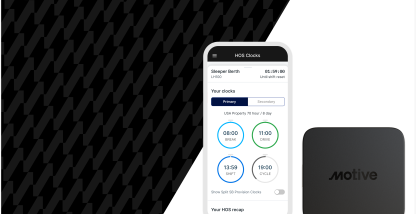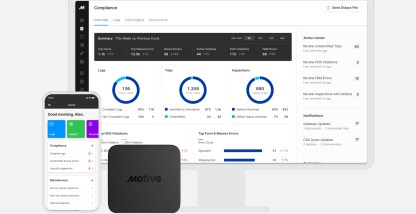A driver’s employment should never depend on their willingness to bend the rules at their managers’ urging. The new ELD mandate and the driver coercion rule could ensure CMV drivers no longer have to choose between doing their job safely and not having a job at all.
Many drivers are concerned the ELD mandate will not actually discourage fleet managers from pressuring them to optimize earnings. Since electronic logging devices make it easier to identify drivers’ hours of service violations, how should truck drivers weigh their employers’ demands against their personal liability for violations they were compelled to make?
In most cases, they probably won’t have to.
Fleets and CMV drivers share a financial and personal interest in complying with FMCSA regulations and the ELD mandate. And where those interests diverge, the industry has created safeguards for drivers.
The ELD mandate ‘driver coercion rule’
The ELD mandate limits drivers’ ability to agree to a reckless employer’s demands. And it also provides evidence that such demands – and any subsequent action taken against the driver for not following them – were made in violation of federal regulations.
One rule in particular should ease driver concerns. As of January 29, the Federal Motor Carrier Safety Administration (FMCSA) has enforced the “driver coercion rule”.
According to the agency, the rule prohibits managers from “coercing drivers to operate in violation of certain FMCSA regulations,” including hours-of-service limits. Fleet managers who are found to have coerced drivers face up to $11,000 in fines.
Democratization of driving data protects drivers
The ELD mandate will provide agencies with the data to identify, investigate, and prosecute cases of driver coercion. In that sense, the ELD mandate empowers drivers to stand up to pressure from managers more than ever before.
Here’s what drivers need to know about the new driver coercion rule, and how the ELD mandate encourages fleet managers and CMV drivers to operate as safely and efficiently as possible.
CMV drivers who vocalize violations are protected
The coercion rule allows drivers to file an official complaint if their employer penalizes them for refusing to perform a task in violation of federal safety regulations. But for drivers who refuse to push past legal limits, they must first inform the dispatcher that fulfilling a particular request would violate safety regulations. Only then can the coercion rule can be applied.
If the dispatcher insists a driver follow the order after being informed that doing so would result in a violation, any immediate threats or subsequent penalty to the driver or their employment is punishable under the driver coercion rule.
Driver coercion incidents must be filed in 90 days
As more fleets are equipped with electronic logging devices, it’s increasingly likely that a dispatcher can determine if a request will put a driver in a bad position. But the way it is currently written, the driver coercion rule has been violated only when “the driver informs the intermediary… of the violation that would occur if the task is performed”, and the intermediary makes “a threat or takes action against the driver’s employment or work opportunities to get the driver to take the load despite the regulatory violation that would occur.”
Simply put, drivers must notify dispatchers of the potential violation for coercion to occur, and this notification should be on the record. Drivers should save emails or text messages in which the demand or threat was made in the event they are penalized for refusing to comply. These drivers must file a complaint with the FMCSA within 90 days of the incident.
Fines for fleets who coerce drivers
While the initial costs of implementing ELDs might motivate some fleets to cut corners, the long-term financial impact of allowing or encouraging drivers to violate regulations will cut even deeper into profits. After all, the ELD, by design, makes these violations impossible to conceal.
For one, if drivers do agree to a carrier’s request to drive past their limit, fleet managers risk inspections with heavy fines and a serious dent to CSA scores. Safety scores are important to carriers — who may also incur the costs of a fleet’s risky behavior. Good fleet managers will be less likely to expose their drivers to HOS violations and associated costs.
But a driver with an ELD who declines to push hours is protected in almost every scenario. Employers should know better than to retaliate. But if they do, CMV drivers can file a complaint to the FMCSA with ELD data on their side.
Fleets can no longer turn a blind eye to risky driving
The coercion rule considers “coercion” in its strictest sense. As anyone with a boss knows, employers can encourage us to cut corners whether they ask us to or not. But with the ELD mandate, it’s much harder to find a case where it’s in the driver’s interest to do so.
With an ELD, it is impossible to “turn a blind eye” to illegal driving. Fleet managers will pay for violations they made happen and violations they let happen.
Fleets have more to gain by following regulations
One of the greatest objections to the ELD mandate could actually be its slogan: Time is money.
The estimated financial gain fleet managers and drivers can expect once all commercial trucks are equipped with an ELD is considerable. While the ELD mandate leaves fleets more exposed to HOS violations, drivers can rest assured that carriers have more to gain by following regulations than by pressuring their fleets to not.
Precise record keeping, automated
Keeping precise records by hand is a challenge for anyone. For truck drivers, a failure to do so can result in significant delays when inspected by an officer. Not to mention the form and manner violations that are almost impossible to avoid when working with paper. Drivers who use ELDs can get through inspections quickly because it is easier for officers to find what they need.
Implications of driving time transparency
In a sense, the ELD mandate relieves some truck drivers of making the choice between doing their job incorrectly and having a job at all. ELDs allow fleet managers to monitor and warn drivers at risk of HOS violations. But they also prevent carriers from claiming they didn’t know a driver was pushing hours when they asked them to go farther.
Final words
The ELD mandate requires drivers to adopt electronic logging devices (ELDs) by December 2017. And it will likely mitigate the number of coercion incidents. See this ELD system demo video to learn how ELDs work and what you can expect from them.
And if you have any questions, contact our support team.








